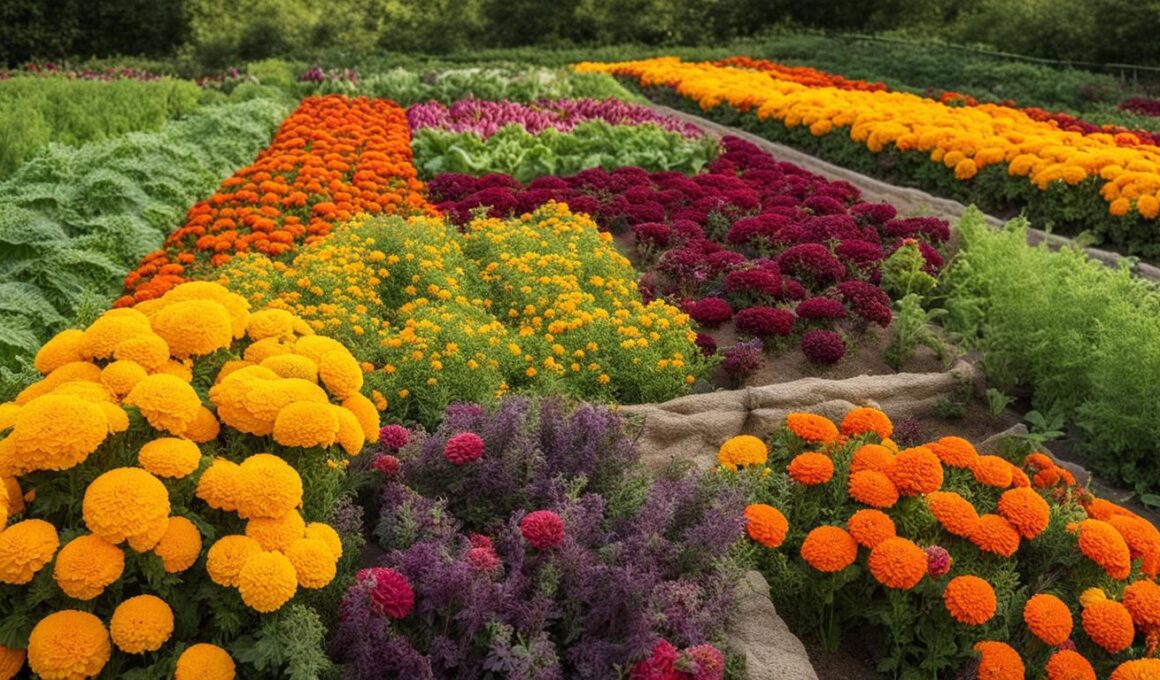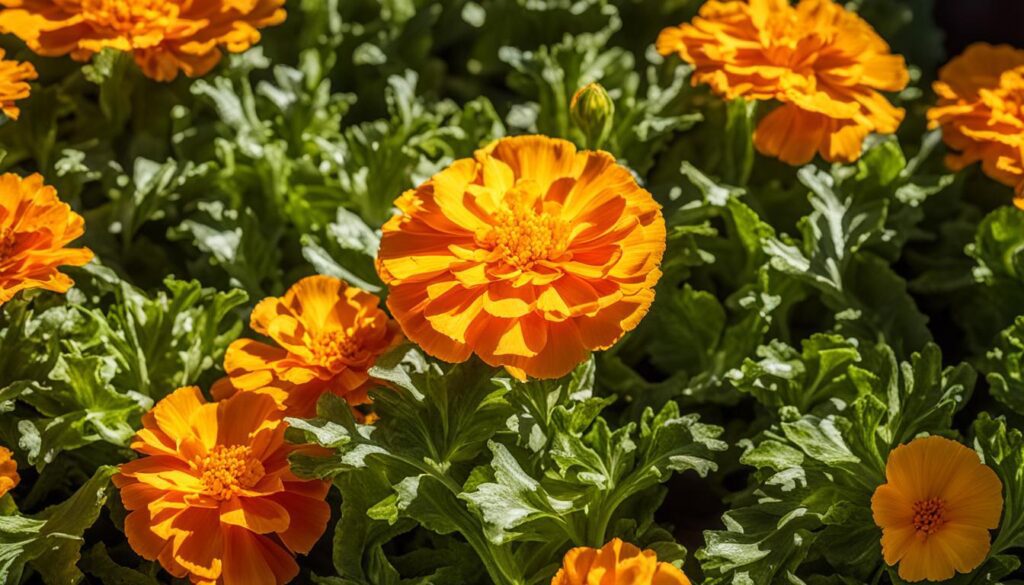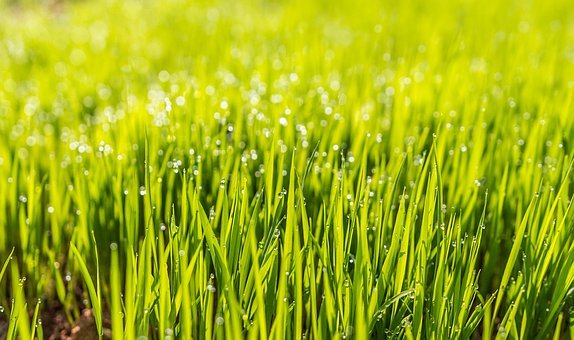Marigolds are not just beautiful flowers, they can also be an excellent addition to your vegetable garden. They offer several benefits such as attracting pollinators, repelling harmful pests, adding biodiversity, and even providing edible petals that can be used in salads and baked goods. By growing marigolds in your vegetable garden, you can boost your harvest and create a more vibrant and healthy garden ecosystem.
Key Takeaways:
- Marigolds are easy to grow and adapt to different soil conditions.
- They attract pollinators and enhance biodiversity in your garden.
- Marigolds repel harmful pests and can control nematode populations.
- The petals of French marigolds are edible and have culinary uses.
- Marigolds add beauty to your garden and can be used for decorative purposes.
Easy to Grow and Versatile
Marigolds are incredibly easy to grow, making them a perfect addition to any garden. Whether you’re a beginner or an experienced gardener, these versatile plants are a great choice. They can be started from seed or purchased as bedding plants, giving you flexibility in how you want to grow them.
Marigolds are known for their adaptability to a wide range of soil conditions. They thrive in full sun and require minimal maintenance. Whether you have sandy soil, clay soil, or loamy soil, marigolds can flourish and add a vibrant touch to your garden.
These plants can be grown in various garden settings, including planters, hanging baskets, ornamental beds, borders, and of course, vegetable gardens. Their bright and colorful flowers can be a beautiful focal point in any garden, adding visual appeal and attracting beneficial insects.
“Marigolds are not only easy to grow, but they are also a versatile plant that can be used in many different ways.” – Gardening expert
Not only are marigolds easy to grow, but they also serve multiple purposes in the garden. From companion planting to trap cropping, marigolds can be used to enhance the overall health and productivity of your garden.
Table: Comparing Different Marigold Varieties
| Marigold Variety | Height | Color | Uses |
|---|---|---|---|
| French Marigold | 6-12 inches | Yellow, orange, red | Companion planting, edible petals, decorative |
| African Marigold | 12-36 inches | Yellow, orange | Cut flowers, decorative, pest repellent |
| Signet Marigold | 6-12 inches | Yellow, orange, red | Culinary uses, edible flowers, groundcover |
In summary, marigolds are easy to grow and versatile plants that can thrive in various soil conditions and garden settings. Their bright and colorful flowers add beauty to any garden, while their adaptability makes them suitable for both beginner and experienced gardeners. Whether you use them as companion plants, trap crops, or simply enjoy their vibrant blooms, marigolds are a valuable addition to any garden.
Companion Plant and Pest Control
Marigolds are not only beautiful flowers, but they also serve as excellent companion plants in your vegetable garden. By planting marigolds alongside your vegetables and herbs, you can naturally control pests and promote a healthier garden ecosystem. Marigolds attract beneficial insects like bees, ladybugs, and lacewings, which help in organic pest control. Additionally, marigolds have chemical compounds in their roots that repel harmful insects and nematodes, making them particularly effective in reducing pest populations.
When it comes to nematode control, certain cultivars of marigolds are known to be highly effective. Varieties such as ‘Tangerine’, ‘Petite Gold’, ‘Petite Harmony’, ‘Goldie’, and ‘Nemagold’ have shown great results in reducing pest nematode populations. To utilize marigolds for nematode control, plant them in a specific location in your vegetable beds before planting other crops. This method can help control nematode populations and protect your vegetables from these damaging pests.
| Marigold Companion Plant Benefits | Nematode Control |
|---|---|
| Attracts beneficial insects like bees, ladybugs, and lacewings | Specific cultivars like ‘Tangerine’, ‘Petite Gold’, ‘Petite Harmony’, ‘Goldie’, and ‘Nemagold’ are effective in reducing pest nematode populations |
| Helps in organic pest control | Plant marigolds in a specific location in your vegetable beds before planting other crops to control nematode populations |
| Repels harmful insects and nematodes |
By incorporating marigolds as companion plants in your vegetable garden, you can benefit from their pest control properties and promote a healthier garden environment for your crops. These vibrant flowers not only add beauty to your garden but also contribute to the overall success of your vegetable harvest.
Attract Pollinators and Enhance Biodiversity
Marigolds are not only beautiful flowers that add vibrant colors to your garden, but they also play a crucial role in attracting pollinators and enhancing biodiversity. Their bright and nectar-rich flowers act as magnets for bees, butterflies, and other beneficial insects, helping to ensure the pollination of your vegetable crops.
By planting marigolds in your garden, you can create a welcoming environment for these important pollinators. Bees, in particular, are essential for the reproduction of many plants, including vegetables. Attracting them to your garden can lead to higher yields and better quality produce.
Additionally, marigolds contribute to enhancing biodiversity in your garden. Their presence attracts a diverse range of insects, including predatory insects that feed on pests like aphids and caterpillars. This natural pest control helps to maintain a healthy balance in your garden ecosystem, reducing the need for harmful chemical pesticides.
Benefits of Marigolds for Biodiversity
- Attracting pollinators: Marigold flowers act as a source of food for bees, butterflies, and other pollinators, ensuring the successful pollination of your vegetable crops.
- Providing habitat: The lush foliage of marigolds provides shelter for beneficial insects, creating a conducive environment for them to thrive.
- Enhancing food chain: By attracting predatory insects, marigolds help establish a natural food chain in your garden, where beneficial insects feed on pests, keeping their populations in check.
- Increasing plant diversity: The presence of marigolds adds variety to your garden, attracting different types of insects and contributing to a more diverse and resilient ecosystem.
Overall, incorporating marigolds into your garden not only adds beauty but also supports the health and vitality of your vegetable crops. The attraction of pollinators and the promotion of biodiversity can greatly improve the success of your garden, leading to higher yields and a more sustainable gardening practice.
Culinary and Decorative Uses
Marigolds offer a wide range of culinary and decorative uses that can add both flavor and beauty to your meals and events. The petals of French marigolds are not only vibrant and visually appealing but also edible, making them a versatile ingredient in various dishes. You can add these edible marigold petals to salads for a pop of color and a slightly tangy flavor. They can also be used as decorative toppings for cupcakes, cakes, and other baked goods, creating an eye-catching presentation.
Furthermore, marigolds can be dried and used in teas, giving your beverages a unique floral aroma. Their vibrant yellow hues make them an excellent natural coloring agent for food, adding a visually pleasing touch to dishes. In addition to their culinary uses, marigolds are also popular for their decorative applications. Whether you’re hosting a special event or simply want to brighten up your home, marigolds can be cut and arranged in floral displays, bringing a vibrant burst of color to any setting.
“The petals of French marigolds can bring a unique flavor and visual appeal to your culinary creations. Their versatility extends beyond the kitchen, as they can also be used to add a vibrant touch to your home decor.”
With their vibrant colors and unique flavor profiles, marigold petals are truly a delightful addition to any culinary or decorative endeavor. From enhancing the visual appeal of your dishes to creating stunning floral arrangements, marigolds can elevate your creativity and impress your guests with their versatility. So go ahead, experiment with these edible petals, and let your imagination run wild!
Table: Culinary and Decorative Uses of Marigold Petals
| Culinary Uses | Decorative Uses |
|---|---|
|
|
As shown in the table above, marigold petals have a range of culinary and decorative uses. Whether you’re exploring new flavors in the kitchen or looking for ways to enhance your visual aesthetics, marigold petals are sure to inspire creativity and leave a lasting impression on your guests.
Can Growing Flowers with Vegetables Help Boost the Harvest of a Marigold Vegetable Garden?
Growing flowers with vegetables can indeed help boost the harvest of a marigold vegetable garden. Marigolds are known to enhance the growth of vegetables, and pairing them with the best flowers for lush garden can create a beneficial environment for both plants, leading to a more bountiful harvest.
Conclusion
Adding marigolds to your vegetable garden offers numerous benefits. By incorporating marigolds into your garden, you can boost your harvest, create a vibrant and healthy garden ecosystem, and enjoy the beauty and versatility of these flowers.
Marigolds are easy to grow and adapt to a wide range of soil conditions. They require plenty of sunlight and can be started from seed or purchased as bedding plants. Whether you’re a beginner or experienced gardener, the addition of marigolds will contribute to a thriving vegetable garden.
In addition to their role as companion plants, marigolds attract pollinators like bees and beneficial insects that help control pests naturally. Their bright colors and nectar-rich flowers make them irresistible to pollinators, resulting in increased pollination of your vegetable crops and enhanced biodiversity in your garden.
Furthermore, marigolds offer culinary and decorative uses. The petals of French marigolds are edible and can be added to salads, used as cupcake decorations, or dried and used in teas. They can also be used as natural colorings in food and for dyeing fabrics due to their vibrant yellow tones. Additionally, marigolds can be cut for floral displays, adding a beautiful pop of color to your home or special events.
So why not give marigolds a try and reap the rewards of a marigold vegetable garden? Incorporating these versatile and beneficial flowers into your garden will not only boost your harvest but also create a more vibrant and healthy garden ecosystem.
FAQ
Can I grow marigolds from seeds?
Yes, marigolds can be easily grown from seeds. They can also be purchased as bedding plants.
What type of soil do marigolds prefer?
Marigolds are adaptable to a wide range of soil conditions. They thrive in full sun conditions.
Are marigolds low-maintenance plants?
Yes, marigolds are low-maintenance plants. They readily self-seed and require minimal care.
Can marigolds be grown in containers or hanging baskets?
Yes, marigolds can be grown in containers, hanging baskets, as well as in ornamental beds, borders, and vegetable gardens.
Are marigolds effective in repelling pests?
Yes, marigolds have chemical compounds in their roots that repel harmful insects and nematodes. They are effective in reducing pest nematode populations.
Do marigolds attract beneficial insects?
Yes, marigolds attract beneficial insects like bees, pollinators, ladybugs, lacewings, hoverflies, and parasitic mini-wasps.
Can I eat marigold petals?
Yes, the petals of French marigolds are edible and can be used in salads, baked goods, teas, and as natural colorings in food.
Can marigolds be used for decorative purposes?
Yes, marigolds can be cut for floral displays, adding a beautiful pop of color to your home or special events. They are also used in dyeing fabrics.
What are the benefits of incorporating marigolds into a vegetable garden?
By adding marigolds to your vegetable garden, you can boost your harvest, attract pollinators, repel harmful pests, enhance biodiversity, and enjoy culinary and decorative uses.











